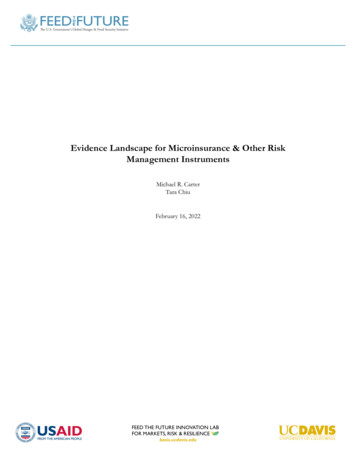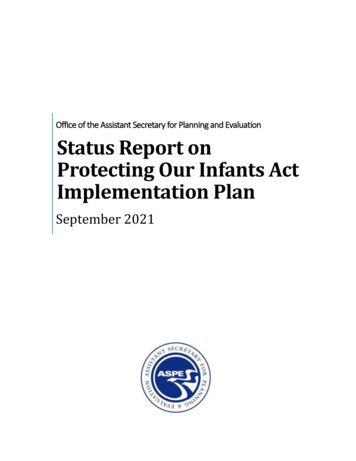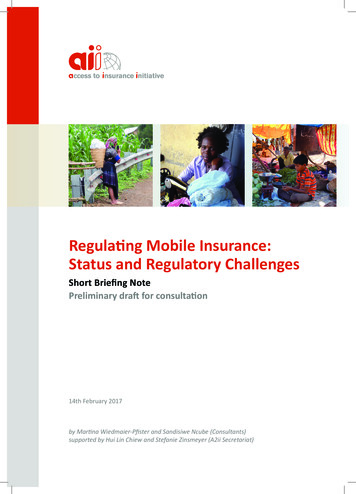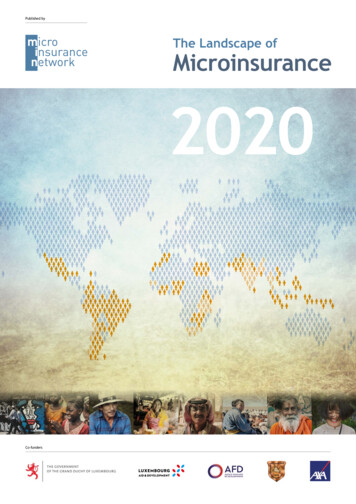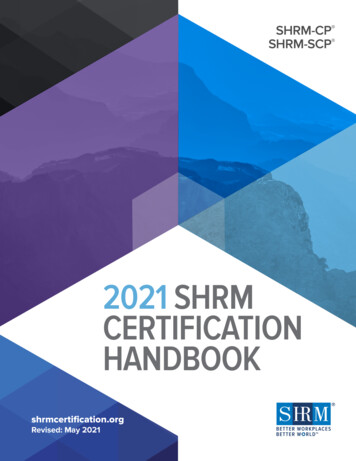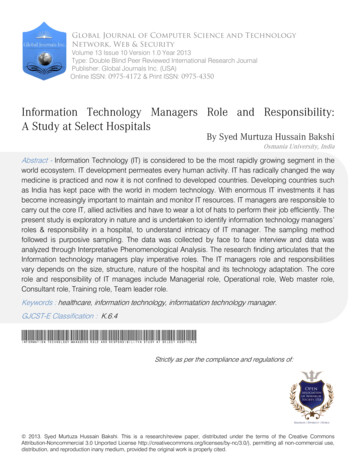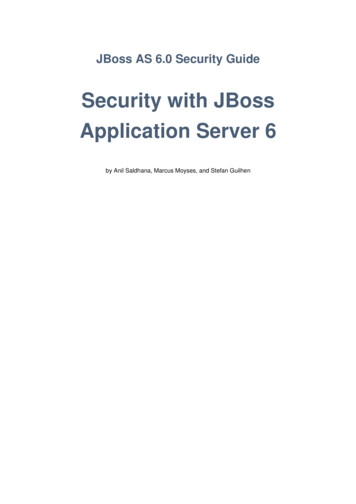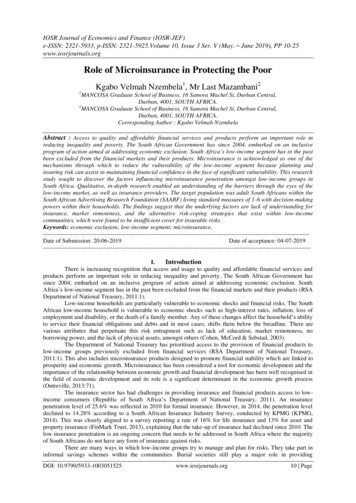
Transcription
IOSR Journal of Economics and Finance (IOSR-JEF)e-ISSN: 2321-5933, p-ISSN: 2321-5925.Volume 10, Issue 3 Ser. V (May. – June 2019), PP 10-25www.iosrjournals.orgRole of Microinsurance in Protecting the PoorKgabo Velmah Nzembela1, Mr Last Mazambani21MANCOSA Graduate School of Business, 16 Samora Machel St, Durban Central,Durban, 4001, SOUTH AFRICA.2MANCOSA Graduate School of Business, 16 Samora Machel St, Durban Central,Durban, 4001, SOUTH AFRICA.Corresponding Author : Kgabo Velmah NzembelaAbstract : Access to quality and affordable financial services and products perform an important role inreducing inequality and poverty. The South African Government has since 2004, embarked on an inclusiveprogram of action aimed at addressing economic exclusion. South Africa’s low-income segment has in the pastbeen excluded from the financial markets and their products. Microinsurance is acknowledged as one of themechanisms through which to reduce the vulnerability of the low-income segment because planning andinsuring risk can assist in maintaining financial confidence in the face of significant vulnerability. This researchstudy sought to discover the factors influencing microinsurance penetration amongst low-income groups inSouth Africa. Qualitative, in-depth research enabled an understanding of the barriers through the eyes of thelow-income market, as well as insurance providers. The target population was adult South Africans within theSouth African Advertising Research Foundation (SAARF) living standard measures of 1-6 with decision-makingpowers within their households. The findings suggest that the underlying factors are lack of understanding forinsurance, market remoteness, and the alternative risk-coping strategies that exist within low-incomecommunities, which were found to be insufficient cover for insurable risks.Keywords: economic exclusion; low-income segment; te of Submission: 20-06-2019Date of acceptance: oductionThere is increasing recognition that access and usage to quality and affordable financial services andproducts perform an important role in reducing inequality and poverty. The South African Government hassince 2004, embarked on an inclusive program of action aimed at addressing economic exclusion. SouthAfrica’s low-income segment has in the past been excluded from the financial markets and their products (RSADepartment of National Treasury, 2011:1).Low-income households are particularly vulnerable to economic shocks and financial risks. The SouthAfrican low-income household is vulnerable to economic shocks such as high-interest rates, inflation, loss ofemployment and disability, or the death of a family member. Any of these changes affect the household’s abilityto service their financial obligations and debts and in most cases, shifts them below the breadline. There arevarious attributes that perpetuate this risk entrapment such as lack of education, market remoteness, noborrowing power, and the lack of physical assets, amongst others (Cohen, McCord & Sebstad, 2003).The Department of National Treasury has prioritised access to the provision of financial products tolow-income groups previously excluded from financial services (RSA Department of National Treasury,2011:1). This also includes microinsurance products designed to promote financial stability which are linked toprosperity and economic growth. Microinsurance has been considered a tool for economic development and theimportance of the relationship between economic growth and financial development has been well recognised inthe field of economic development and its role is a significant determinant in the economic growth process(Outreville, 2013:71).The insurance sector has had challenges in providing insurance and financial products access to lowincome consumers (Republic of South Africa’s Department of National Treasury, 2011). An insurancepenetration level of 25.6% was reflected in 2010 for formal insurance. However, in 2014, the penetration leveldeclined to 14.28% according to a South African Insurance Industry Survey, conducted by KPMG (KPMG,2014). This was closely aligned to a survey reporting a rate of 16% for life insurance and 13% for asset andproperty insurance (FinMark Trust, 2013), explaining that the take-up of insurance had declined since 2010. Thelow insurance penetration is an ongoing concern that needs to be addressed in South Africa where the majorityof South Africans do not have any form of insurance against risks.There are many ways in which low-income groups try to manage and plan for risks. They take part ininformal savings schemes within the communities. Burial societies still play a major role in providingDOI: 10.9790/5933-1003051525www.iosrjournals.org10 Page
Role of Microinsurance in Protecting the Poorunregulated insurance, registered under the Friendly Societies Act 25 of 1956, and a large majority of those withfuneral insurance are covered under these unregulated structures, which is a dilemma common to South Africain particular. Currently, only less than one per cent of the entire poor population, which makes up 60% of thetotal population, are covered with short term insurance and this number must be raised to 6% as per theFinancial Services Board (FSB) charter targets.According to Churchill and McCord (2012), most low-income people work in the informal sectors ofthe economy and men and women mostly face similar risks. Their exposure to those risks and its impact,however, differs greatly depending on their social, financial and cultural statuses. Seventy per cent of theworld’s poor is made up of women. Therefore, there is a larger concentration of women at the bottom of theequality and life security chain. Microinsurance as a possible solution for risk protection is designed to takethese specific risks into consideration. Even though gender equality cannot be achieved solely throughmicroinsurance, it can surely be one of the effective tools together with other structural gender discriminationsthat should be addressed to improve the strategic positioning of women. Churchill and McCord (2012:12-13)define microinsurance as the protection of low-income customers against specific risks in exchange for regularpremium payments proportionate to the likelihood of the risk occurring and the cost of the risk involved.Microinsurance is no different from conventional insurance. It differs in that it is designed with the low-incomegroup in mind. The design is founded on research and an understanding of the low-income segment.Microinsurance is a mechanism for mitigating risks for the low-income segment of the market, which when ineffect helps to reduce vulnerability to poverty (Radermacher & Brinkmann, 2011). Through microinsurance, thelow-income household can have a sense of protection and financial confidence in the face of significantvulnerability. Risk pooling and informal insurance have been researched exhaustively and found to be limited inbenefits and typically only cover a portion of the loss. Microinsurance has not been effective for the low-incomesegment as penetration rates for microinsurance products are very low at 14,28% (KPMG, 2014:49). It isestimated that only 5% of the potential microinsurance market is covered, which means that there are reasonswhy the low-income segment does not take-up insurance products designed to help them cope with financialrisks. A key aspect of this research is to investigate reasons for low penetration levels of microinsurance withinthe low-income segment and to explore ways to significantly increase microinsurance access.The financial inclusion level in SA is at 14,28% (KPMG, 2014:49). This research considers thelandscape of access such as products and services, the costs to the low-income household, the distributionchannel, and the education of the low-income client regarding insurance and mitigating factors, in order tounderstand the reasons for the low penetration of microinsurance. Before microinsurance can be made availableon such a vast scale, a number of barriers have to be overcome (FinScope SA, 2013). Some barriers are externalconstraints, such as delivery constraints, some are shortcomings of existing products, some are related topeople’s perceptions about insurance in general, and others are related to insurance regulations or their absencethereof. The delivery channel is one of the most significant barriers and constraints for the expansion ofmicroinsurance (Munich Re Foundation report, 2013:25).1.1 Research objectivesThe objectives of this research study are as follows:To determine the role of microinsurance in protecting the low-income segment in South Africa against financialrisksTo determine the landscape of microinsurance access to low-income consumers in South Africa.To identify the drivers of the usage of microinsurance products and services by low-income consumers in SouthAfrica.To identify the barriers to the usage of microinsurance products and services by low-income consumers in SouthAfrica.To make recommendations on deepening microinsurance penetration to the low-income households in SouthAfrica to ensure much safer financial risk management.1.2 Significance of the studyThe Department of National Treasury has prioritised access for the provision of financial products tolow-income groups previously excluded from financial services (RSA Department of National Treasury,2011:1). This also includes microinsurance products designed to promote financial stability which are linked toprosperity and economic growth. Microinsurance has been considered as a tool for economic development andthe importance of the relationship between economic growth and financial development has been wellrecognised in the field of economic development and its role is a significant determinant in the economic growthprocess (Outreville, 2013:71).The motivation for this study is the high prevalence of people in South Africa living on and below thepoverty line, unable to fulfil their monthly financial obligations. This suggests that the majority are one monthDOI: 10.9790/5933-1003051525www.iosrjournals.org11 Page
Role of Microinsurance in Protecting the Pooraway from poverty should there be any long-term illnesses, loss of income, death, or natural disasters that canoccur.Microinsurance is proposed as an effective mechanism to protect the low-income market from potentialfinancial risks. Many challenges, such as low penetration levels, exist in the microinsurance space and if theyremain unresolved, they leave the low-income market without effective risk management and risk copingstrategies. If challenges to penetration are addressed, microinsurance can be resourced and can create a bettermomentum for development.The respondents for this research were insurance professionals currently offering insurance to the lowincome market. The research sought to learn from the experience of these individuals and to interview lowincome households to gain a better understanding of their risks and challenges as well as to develop potentialsolutions associated with providing insurance to the low-income market. A key aspect of the study was toanalyse information and explore ways in which we can significantly increase the microinsurance penetrationlevels towards low-income households. The study analyses the current product offerings and evaluates whetherthey can be enhanced to create demand and meet the needs/demands of the low-income group.II.Literature ReviewTadesse and Brans (2012:79) define microinsurance as a risk-pooling mechanism that combinesresources of many insurance policyholders to compensate for the accidental losses of a few. Microinsurance isno different from conventional insurance. It only differs in that it is designed with the low-income group inmind. The design is founded on research and an understanding of the low-income segment. Biener and Eling(2012:77) argue that just downsizing conventional insurance product for the low-income consumer is not aneffective way of approaching this market as the product must be designed with low-income consumers in mind.Microinsurance is based on the same principles as other traditional insurances, however, with a numberof key differences. The sizes of the transactions are smaller in value and premiums are lower. The target marketconsists of low-income consumers, with limited knowledge of insurance products and their benefits. Productsoffered are simpler, often providing just one type of cover rather than bundles. Due to the irregular income ofthe low-income group, products are designed to allow flexibility of premium payments. The micro-insurer mightallow irregular payments, at irregular times and in uneven amounts. The claims process of a microinsuranceclient is faster in South Africa as the claim is typically paid within 48 hours and the process is less complicatedand involves substantially less documentation. There is less regulation enforced on micro-lenders andunderwriting is a simpler process with fewer terms, conditions and exclusions.According to Biener and Eling (2012), there are key characteristics that differentiate conventionalinsurance from microinsurance programs:The product offering must be relevant to the risk of low-income households. Insurance products cannotsimply be downsized from the conventional insurance product to the low-income client with a blanket approachtowards the low-income client. It will not be successful.Products must be developed with the low-income client in mind, supported by market research.While conventional insurance tends to exclude certain high risk persons, microinsurance is generallyinclusive as it’s seen as an extension of social protection. Because of the generally low amounts of insuranceprotection by the low-income market, the cost of identifying a high-risk person may be higher than the costs ofexcluding them in the first place.According to Churchill (2012), the following points need to be considered when implementinginsurance for low-income clients:Product demand is critical. There should be flexibility in the product design that enables the product to bedesigned together with the client specifically to ensure that the most needed coverage is included.Distribution channels and premium collections. Distribution should likely be by someone who understandsthe culture of the target community and their needs.Affordable premiums. This should be made affordable for the customer to avoid insurance lapses.Adverse selection. The waiting period should be done strategically, long enough to discourage abuse and shortenough not to be prohibitive.Easy claims process. Elaborate claims processes usually result in dissatisfaction from a low-income client. Theprocess should be simple, short with less paperwork.Less contestability for existing illnesses. There is usually contestability of death arising from existing illnesses.This can be very difficult to implement as most clients from poor communities do not have formal medicalrecords and in reality, this contestability is very difficult to explain to the client.Minimal exclusions. A long list of exclusions is hard for sales staff to explain and difficult for clients tounderstand.DOI: 10.9790/5933-1003051525www.iosrjournals.org12 Page
Role of Microinsurance in Protecting the PoorOne price. Even though it is standard practice for insurance to calculate insurance differently for different agesand sex, this can be difficult to understand by the low-income client. Simplification of information is necessaryand a single rate and benefits are necessary, unless in cases where clients design their own products.Simplified sales promotions. Sales staff must be effectively trained on the products to ensure the insurer doesnot lose trust and credibility with the clients and potential clients. Sales presentations should concentrate on theimportant factors such as the risk coverage, benefits, costs, and who will be covered.Exclusions. Some micro-insurers have previously implemented exclusions for HIV/Aids death causes andhealth treatment but soon realised that it was an impractical solution. HIV/Aids is rarely stated as a cause ofdeath as it is usually the opportunistic diseases such as Tuberculosis, pneumonia, or other opportunistic diseases.This particular challenge rendered the exclusion ineffective. Insurers have since included HIV/Aids patients inthe cover and for some insurers, the tests are done upfront and the risk gets priced accordingly. For otherinsurers, no tests are required. However, it seems to be assumed that most low-income clients could have thedisease and this is considered in the product design, its benefits and costs.2.1 Distribution models2.1.1 Community-based modelAccording to Churchill (2012), this is an alternative distribution model introduced over the past fewyears which still offer many opportunities for micro-insurers. There are many alternative channels in whichclients can access the financial products particularly short term loans and microinsurance. Some of the channelsunder this model include retailers, workers’ unions, direct sales channels, cell phone payments, burial societiesand worksite marketers. While these structures are great and reduce the marketing and distribution costs, theyusually work in developing countries as with the low-income market, the level of education for insuranceproducts is not always sufficient to implement such distributions. There is also a role performed by agents andindependent distributors that can add value to this market.2.1.2 South African distribution trends by the Association for Savings & InvestmentsIn South Africa, the distribution of life insurance products follows a similar mix as seen in othercountries. Independent brokers distribute the majority of business, followed by tied agents. This situation hasbeen largely unchanged over the last five years. Independent brokers are particularly dominant in the singlepremium and retirement annuity recurring premium business, as an ordinary, recurring, premium business. Theyplay a far larger role, particularly in terms of volume of policies sold. The direct channel in South Africaaccounts for a small portion of the total investment and risk market, but as with international examples has a farhigher proportion of the total risk market2.1.3 Technology as a potential channel of distribution for microinsuranceTechnology plays a critical role in disseminating information which could be utilised for education,marketing and sales. Many industries such as retailers already leverage technology for product sales. LSM 1-6has a very high penetration level averaging 68%, however much higher in LSM 4-6. Expanded technologythrough cell phone and computer improves access.2.2 Marketing benefitsAccording to Churchill (2012), some of the marketing tactics that have proven successful by insurers includes:2.2.1 Cashback benefitsIn marketing insurance, a key challenge is to assure potential clients that they are getting value formoney particularly if they do not claim as many see this as a waste of money. To help address this problem,most insurance provides a non-claim benefit which is the amount that gets paid back to the insured should theynot claim after a certain period of time.2.2.2 Premium collectionsThe process of collecting insurance cover premiums from the low-income market is a major challengefor insurers as mostly are informally employed and self-employed without a banking or savings account so theusual deduction from the salary with the employer and the debit order does not work for many in this market. Bydefinition of the low-income market, most have irregular income which presents a challenge of scheduling apremium payment.2.3 Creating demand for microinsuranceIn an attempt to increase the demand of microinsurance by the low-income consumer, Tadesse andBrans (2012:80) argue that the microinsurance demand is dependent on the need for the risk to be transferred,DOI: 10.9790/5933-1003051525www.iosrjournals.org13 Page
Role of Microinsurance in Protecting the Poorthe transfer of risk is determined by the severity of that risk and the probability of that risk occurring.According to Tadesse and Brans (2012), the attitude towards insurance is dependent on these three factors: theperceived value of insurance as a concept and knowledge of how insurance works; the accessibility of insurance,affordability and product delivery; the trust of low-income group towards the product offering and the provider.The research will ascertain if there is an acknowledgement of the existence of risk amongst the low-incomeclients and understand their perceived value or lack thereof for microinsurance.2.3.1 Determinants of demand for microinsuranceUnderstanding insurance: There is a widely held belief that a lack of understanding of insurance by lowincome households is the key reason they do not buy insurance. Platteau and Ugarte (2013), however, bring in apiece of mixed evidence that suggests that an increased knowledge of insurance does not always translate intoimproved or higher demands.Client and value proposition and perception: There is evidence that suggests that there is a link between theclient’s value and demand and that the product or service that delivers the best-perceived value is likely to havea greater demand and produce greater returns over time (Matul, Dalal, De Bock & Gelade, 2013, Magnoni &Zimmerman, 2011, & McCord et al., 2012). The traditional marketing strategic elements referred to as 4P’s(Product, Price, Place and Promotion) of which the first three define the value proposition and the last onepromotes it, are the tools that can be utilized to ensure there are no misperceptions. PACE which refers toProduct, Access, Cost and Experience is a tool developed to assess the client value of insurance products bycomparing it with other products or other means of protection for the same risk. PACE looks at both productsspecification and processes.Wealth and liquidity constraints: Cole, Giné, Tobacman, Topalova, Townsend and Vickery (2011) provideevidence that liquidity constraints limit demands for insurance. The report suggests that wealthier peoplepurchase insurance because they don’t have liquidity constraints similar to the low-income client. Low-incomehouseholds are innately sensitive to price changes. Economically when prices increase, demand decreases andvice versa. However, Cole et al. (2011) argue that low price alone is not enough to create a high demand. Cole etal. (2011) observed that even when prices were below actuarial prices, there was still a low uptake and thatwhen health insurance was offered for free for an initial period, they only achieved a 30% take-up. However,this rose to 90% when there was heavy subsidisation by the government and great incentives offered to thoseselling the product.Trust: Central to the effort of insurance and the financial sector is trust. Dong, De Allegri, Gnawali, Souaresand Sauerborn (2009) provided three strategies to building trust for insurance practitioners. Product strategymust be portrayed in the product claim, value-added services, and communication. Institutional strategy,includes having trusted agents and representatives of the organisation and lastly, community strategy involvesinfluencing peer pressure.2.4 Behavioural factorsDalal and Marduch (2010) state that the science of sales is built on the understanding of human psychology andnot just economics. Some of these behavioural behaviours are driven by the following:Loss aversion: People place greater value on loss than gain. An example of this is when you sell insurance asone could lose the property without such insurance versus selling peace of mind that you have insurance. Cole etal. (2011) found that the message with negative wording increases the level of take-up significantly and thatnone of the positive wording had such a significant impact.Effect of past shock: Cole et al. (2011) demonstrated that the experience of a certain type of risk or hazardtowards a certain risk in the past, increases chances of take-up for the same risk in the future. Evidence showedthat if a farmer experiences inclement weather in the past, they are likely to acquire crop insurance in the future.However, Galarza and Carter (2010) suggest that a farmer might think that the misfortune will not repeat itself,resulting in not taking up insurance. There is also evidence that hearing of others’ experiences of risk stronglyimpacts on the demand for the product.Peer influence: Several pieces of evidence show that peer influence is one of the critical parts of the decisionmaking process, particularly for the low-income market. People attending village meetings tend to influenceeach other in the purchases of certain products and services. Internet retailer Amazon leverages the power ofpeer pressure by suggesting to the user what their peers are purchasing.Other risk coping strategy: People have other alternative tools to protect themselves against risks. There areself-insurance strategies such as saving and informal risk-sharing insurances such as communal burial societiesDOI: 10.9790/5933-1003051525www.iosrjournals.org14 Page
Role of Microinsurance in Protecting the Poorthat partially protect against risk. By complementing informal risk-sharing, the insurers will be able to stimulatedemand (Matul & Suministrado, 2012).Microinsurance effect on the economy: Microinsurance is seen as a vehicle to promote financial stability,linked to a form of prosperity and economic growth because of the microinsurance’s protection of householdsfrom different kind of risks that affect economic activity in different ways (Outreville, 2013:97). Risk is aconstant in life and is ever present. However, the poor are greatly affected by risks in the absence of riskmanagement instruments. The impact of the shocks on household income and assets as adapted from McCord(2005) suggest that people who receive a low-income continually struggle to improve their lives. They find thatfinancial shocks can easily erode their hard-earned cash, which can plunge them below the poverty line for thosewithout risk management options.The role of the microinsurance is to temper the downturns, which are impediments to escaping poverty. Tomand Selvam (2010:7) found a correlation between living standards, education level of children, safeguarding ofassets and poverty reduction of rural people with health and asset microinsurance. Microinsurance provides anopportunity for the low-income segment to build from the bottom-up ultimately making a stronger contributionto general economic development (Churchill & Matul, 2012:51).2.5 Risk overviewRisk is the chance of a loss or a loss itself. Aven and Renn (2009:1) defines risk as an event or situationwhere something of human value could be lost and yet the outcome is uncertain. Risk is also defined as aprobability and severity of adverse effect (Aven, 2011:515). Risks may come from natural disasters, life cycle,economic changes and health. Not every risk can be pooled and insured. There are preconditions that the riskhas to meet in order for the risk to be insurable and transferrable into insurance.2.5.1 Low-income customerFin Mark Trust (2013:12) defines low-income consumers, as individuals within LSM 1-6 range. Thisselection is based on the average household income. The following four clusters were developed based on theadult population:BOP (11 194 000) 35.8%The Core (10 534 000) 33.7%The Buttress (5 105 000) 16.3%The Apex (4 463 000) 14.3%The South African Advertising Research Foundation (SAARF) is a market segmentation tool whichdeveloped living standard measures (LSM) for South Africa’s adults, regardless of their ethnicity or location.Hofstede (2011:11) developed a theory that suggests that there is a breakdown between individualism andcollectivism in South Africa and that the wealthy are individualistic and the poorer are collectivistic.Figure 2.7: Lifestyle measure (LSM) groups for the South African adult population2.5.2 How big is the low-income market in SA?This is an overview of the South African population and a statistical analysis of the low-income group based onthe LSM groups.Total adult (16 ) population36.4 million63% reside in urban areas 39% are under 30 years of age52% receive money through salary/wage50% earn a personal income of less than R2 000 per month (this includes 11% who do not have a personalmonthly income)LSM 1-2 in South Africa (adults) 658 thousand14% - No Water21% - No ToiletsDOI: 10.9790/5933-1003051525www.iosrjournals.org15 Page
Role of Microinsurance in Protecting the Poor78% - No ElectricityLSM 3-4 in South Africa (adults) 5.9 million11% - No water11% - No toilets20% - No electricity2.6 Characteristics of the low-income consumerLow-income consumers are vulnerable to any economic changes or shocks. The vulnerability relates tothe inability to deal with risks (Bali Swain & Floro, 2014:541). When there is a lack of income, health products,education and basic services manifest into poverty. Poverty and vulnerability reinforce each other (Akotey,2011:183). Indebtedness from micro-lenders and credit purchases where clients pay in instalments with interestare some of the characteristics of a low-income consumer (Bali Swain & Floro, 2014:542).2.6.1 Low-income consumer behaviourConsumer behaviour is the study of individuals, groups and organisations, the processes they follow tomake buying decisions and the impact these processes have on consumers and society (Chen, Chen & Huang,2012:106). Factors that influence consumer behaviours include cultural background, religious backg
Financial Services Board (FSB) charter targets. According to Churchill and McCord (2012), most low-income people work in the informal sectors of the economy and men and women mostly face similar risks. Their exposure to those risks and its impact,
